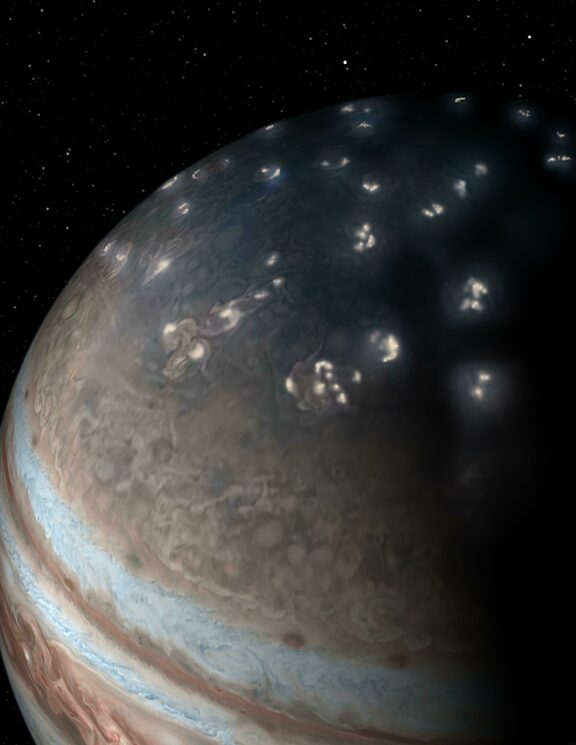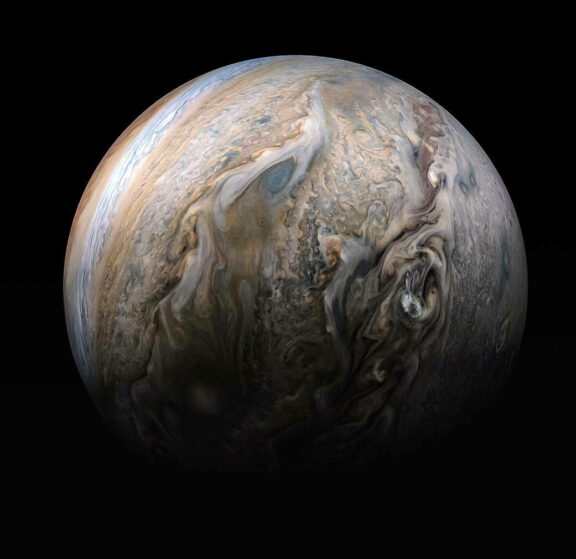Why lightning on Jupiter is a planetary unsolved mystery

Written by
Rae Paoletta
Director of Content & Engagement, The Planetary Society
May 4, 2021
Jupiter is an extraordinarily beautiful and deeply chaotic world. Its weather lacks subtlety in the best way.
NASA’s Juno spacecraft has been investigating the planet for nearly five years, revealing new depths to the drama and splendor of this profoundly strange place. It’s also shed light on some of the planet’s biggest atmospheric mysteries, including the unusual nature of Jupiter’s lightning.
As Juno gears up for its extended mission beginning in August 2021, it’s worth taking a look back at why Jupiter’s lightning remains one of its most fascinating enigmas.
Wait, there’s lightning on Jupiter?
Yes, but for a long time, no one knew for certain. In fact, until 1979, lightning on Jupiter was just a hypothesis; its existence wasn’t confirmed until NASA’s Voyager 1 spacecraft picked up radio signals typically indicative of lightning. There was just one catch: the radio waves were in a completely different range from lightning found on Earth.
In the decades that followed, NASA’s Voyager 2, Galileo and Cassini spacecraft also discovered radio evidence of lightning on Jupiter. But the instruments used in these missions weren’t sensitive enough to provide a full picture of Jovian lightning. After Juno arrived in the Jupiter system in July 2016, however, data started trickling in: the spacecraft’s Microwave Radiometer Instrument (MWR) detected 377 lightning discharges in its first eight flybys.
The data helped scientists understand where lightning is distributed on the gas giant and get a clearer sense of how often it occurs. The information also showed how much of the Jovian puzzle they were missing. New data and detail from Juno have sparked more questions than ever before.

Shocking twists within Jupiter’s thunderstorms
Even on Earth, lightning is something of an unsolved mystery. We know that typically in cloud-to-ground lightning, negative charges in a thundercloud square off against positive charges on the ground. Just like a battery, opposites attract, and an electric discharge is released in the form of a lightning flash.
Still, there are gaps in our understanding that could be answered through further research of Jovian lightning, and vice versa.
With the information we have, it seems there are some similarities in the basic mechanics of lightning on both planets. But for so many reasons—like the composition of Jupiter’s atmosphere—there are stark differences. On Earth, most of our lightning strikes around the equator, but on Jupiter, it seems more prevalent in the hemispheres, specifically the northern one. This is certainly on-brand for Jupiter, given that its north pole is already pandemonium; it appears to be home to a cluster of cyclones.
Why lightning doesn’t seem to strike Jupiter’s equator is still largely unknown. There’s evidence to suggest it might be influenced by the way weather forms on Jupiter in general, which is very different from how weather works on our planet. Terrestrial weather, for example, mainly forms in the troposphere, which is the layer of atmosphere closest to Earth. So many of our natural occurrences are influenced by the Sun and the fact that our planet has solid ground.
Jupiter, on the other hand, doesn’t have a “true” surface. Its weather seems to be driven by powerful forces deep within the planet, which may give rise to the gas giant’s spectacular tempests.
Though the amount of sunlight Jupiter receives seems to play a role in its weather, the connection isn’t totally understood. According to NASA, since the planet is 757 million kilometers (about 470 million miles) from the Sun, it gets about 25 times less sunlight than Earth. It’s possible that sunlight creates more balanced upper atmospheric conditions near Jupiter’s equator, where the planet receives more sunlight, and greater instability toward the poles, since warm air from deep within the planet is able to rise freely. This instability is ideal for lightning to form.
Of course, as is typically the case with Jupiter, there’s rarely one answer that neatly explains everything. It’s possible that Jupiter’s magnetic field could be somehow linked to the planet’s weather processes, and in theory, lightning. In Juno’s extended mission, scientists hope to get more high-resolution data from the spacecraft’s suite of instruments that will give further evidence to support theories – or offer up new ones.
Shallow lightning and “mushballs”
Here’s where Jupiter’s mystery multiplies yet again: recent findings suggest the gas giant is home to more than one type of lightning.
The lightning detected by prior spacecraft seems to originate in the water clouds deep within Jupiter’s atmosphere. This kind of lightning seems to be generated in conditions that are somewhat similar to those on Earth, i.e. from a water cloud. But more recently, Juno has found evidence of a “shallow lightning” that seems to come from somewhere high in Jupiter’s atmosphere.
Juno's low-light star-tracking camera, the Stellar Reference Unit (SRU), first spotted shallow lightning while investigating Jupiter’s dark side. The SRU found lightning flashes that were uncharacteristically small and “shallow” compared to the lightning previously discovered.
In Jupiter’s high-altitude atmosphere, temperatures can plummet lower than -88 degrees Celsius (-126 degrees Fahrenheit), which is far too cold to support liquid water. There is, however, hypothetically some kind of ammonia-water hail in this region. Juno scientists realized there could be a link between this and the shallow lightning they observed.
Enter the pièce de résistance of shallow lightning: “mushballs.'' According to researchers, it all starts when Jupiter’s violent storms catapult water high up into Jupiter’s atmosphere, where it freezes into ice crystals. The ice crystals then combine with ammonia gas, which melts it like antifreeze. Over time, these ammonia-water raindrops collide with ice crystals from Jovian updrafts, creating friction and thus, the conditions to form lightning.
The idea of this ammonia-water hail could not only be a clue to the formation of shallow lightning, it may also explain why parts of Jupiter’s atmosphere seem to be missing ammonia. In a sense, the existence of this antifreeze sludge would be killing two proverbial birds with one mushball.

Unsolved mysteries that remain
Jupiter is likely the oldest planet in our solar system and yet, it’s hardly begun to share its secrets. By furthering our understanding of Jovian weather—including lightning—we’re able to learn more about the gas giant’s origins, and by extension, our entire cosmic backyard.
Juno’s extended mission will be a critical part of this. As it moves closer and closer to the planet, we’ll get a better understanding of Jupiter’s lightning as well as its massive storm systems and its polar cyclones. Scientists on the mission say they hope to get more evidence of the mushballs, too.
If there’s one thing Jupiter’s very good at, it’s anarchy and surprises. While no one knows what Juno’s next mission will reveal, it definitely won’t be boring.
Support our core enterprises
Your gift today will go far to help us close out the year strong and keep up our momentum in 2026.
Donate

 Explore Worlds
Explore Worlds Find Life
Find Life Defend Earth
Defend Earth

